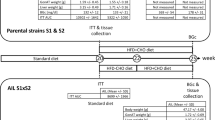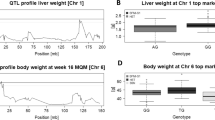Abstract
The TALLYHO (TH) mouse presents a metabolic syndrome of obesity, type 2 diabetes, and hyperlipidemia. Highly significant quantitative trait loci (QTLs) linked to adiposity and hypercholesterolemia were previously identified on chromosome (Chr) 1 in a genome-wide scan of F2 mice from C57BL/6J (B6) x TH. In this study, we generated congenic mouse strains that carry the Chr 1 QTLs derived from TH on a B6 background; B6.TH-Chr1-128Mb (128Mb in size) and B6.TH-Chr1-92Mb (92Mb in size, proximally overlapping). We characterized these congenic mice on chow and high fat (HF) diets. On chow, B6.TH-Chr1-128Mb congenic mice exhibited a slightly larger body fat mass compared with B6.TH-Chr1-92Mb congenic and B6 mice, while body fat mass between B6.TH-Chr1-92Mb congenic and B6 mice was comparable. Plasma total cholesterol levels were significantly higher in B6.TH-Chr1-128Mb congenics compared to B6.TH-Chr1-92Mb congenic and B6 mice. Again, there was no difference in plasma total cholesterol levels between B6.TH-Chr1-92Mb congenic and B6 mice. All animals gained more body fat and exhibited higher plasma total cholesterol levels when fed HF diets than fed chow, but these increases were greater in B6.TH-Chr1-128Mb congenics than in B6.TH-Chr1-92Mb congenic and B6 mice. These results confirmed the effect of the 128Mb TH segment from Chr 1 on body fat and plasma cholesterol values and showed that the distal segment of Chr 1 from TH is necessary to cause both phenotypes. Through bioinformatic approaches, we generated a list of potential candidate genes within the distal region of Chr 1 and tested Ifi202b and Apoa2. We conclude that Chr 1 QTLs largely confer obesity and hypercholesterolemia in TH mice and can be promising targets for identifying susceptibility genes. Congenic mouse strains will be a valuable resource for gene identification.




Similar content being viewed by others
References
Ashburner M, Ball CA, Blake JA, Botstein D, Butler H, Cherry JM, Davis AP, Dolinski K, Dwight SS, Eppig JT, Harris MA, Hill DP, Issel-Tarver L, Kasarskis A, Lewis S, Matese JC, Richardson JE, Ringwald M, Rubin GM, Sherlock G (2000) Gene ontology: tool for the unification of biology: the gene ontology consortium. Nat Genet 25(1):25–29
Bandarian F, Daneshpour MS, Hedayati M, Naseri M, Azizi F (2016) Identification of sequence variation in the apolipoprotein A2 gene and their relationship with serum high-density lipoprotein cholesterol levels. Iran Biomed J 20(2):84–90
Bochud M, Marquant F, Marques-Vidal PM, Vollenweider P, Beckmann JS, Mooser V, Paccaud F, Rousson V (2009) Association between C-reactive protein and adiposity in women. J Clin Endocrinol Metab 94(10):3969–3977
Castellani LW, Goto AM, Lusis AJ (2001) Studies with apolipoprotein A-II transgenic mice indicate a role for HDLs in adiposity and insulin resistance. Diabetes 50:643–651
Denvir J, Boskovic G, Fan J, Primerano DA, Parkman JK, Kim JH (2016) Whole genome sequence analysis of the TALLYHO/Jng mouse. BMC Genom 17(1):907
Devalaraja-Narashimha K, Padanilam BJ (2010) PARP1 deficiency exacerbates diet-induced obesity in mice. J Endocrinol 205(3):243–252
Doo M, Kim Y (2015) Obesity: interactions of genome and nutrients intake. Prev Nutr Food Sci 20(1):1–7
Dron JS, Hegele RA (2016) Genetics of lipid and lipoprotein disorders and Traits. Curr Genet Med Rep 4(3):130–141
Erion KA, Corkey BE (2017) Hyperinsulinemia: a cause of obesity? Curr Obes Rep 6(2):178–186
Flynt A, Daepp MIG (2015) Diet-related chronic disease in the northeastern United States: a model-based clustering approach. Int J Health Geogr 14:25
Garlanda C, Bottazzi B, Bastone A, Mantovani A (2005) Pentraxins at the crossroads between innate immunity, inflammation, matrix deposition, and female fertility. Annu Rev Immunol 23:337–366
Gene Ontology Consortium (2015) Gene Ontology Consortium: going forward. Nucleic Acids Res 43(Database issue):D1049–D1056
Harris RA, Alcott CE, Sullivan EL, Takahashi D, McCurdy CE, Comstock S, Baquero K, Blundell P, Frias AE, Kahr M, Suter M, Wesolowski S, Friedman JE, Grove KL, Aagaard KM (2016) Genomic variants associated with resistance to high fat diet induced obesity in a primate model. Sci Rep 6:36123
Jenny NS, Arnold AM, Kuller LH, Tracy RP, Psaty BM (2007) Serum amyloid P and cardiovascular disease in older men and women: results from the Cardiovascular Health Study. Arterioscler Thromb Vasc Biol 27(2):352–358
Kawakami K, Onaka T, Iwase M, Homma I, Ikeda K (2005) Hyperphagia and obesity in Na,K-ATPase alpha2 subunit-defective mice. Obes Res 13(10):1661–1671
Kim JH, Saxton AM (2012) The TALLYHO mouse as a model of human type 2 diabetes. Methods Mol Biol 933:75–87
Kim JH, Sen S, Avery CS, Simpson E, Chandler P, Nishina PM, Churchill GA, Naggert JK (2001) Genetic analysis of a new mouse model for non-insulin-dependent diabetes. Genomics 74(3):273–286
Kim JH, Stewart TP, Zhang W, Kim HY, Nishina PM, Naggert JK (2005) Type 2 diabetes mouse model TallyHo carries an obesity gene on chromosome 6 that exaggerates dietary obesity. Physiol Genom 22(2):171–181
Kimura J, Ichii O, Nakamura T, Horino T, Otsuka S, Kon Y (2014) BXSB-type genome causes murine autoimmune glomerulonephritis: pathological correlationbetween telomeric region of chromosome 1 and Yaa. Genes Immun 15(3):182–189
Li H, Liu F, Guo H, Zhu Z, Jiao Y (2014) Role of interferon-inducible protein 202 (p202) in the regulation of adipogenesis in mouse adipose-derived stem cells.Mol Cell Endocrinol 382(2):814–824
Livak KJ, Schmittgen TD (2001) Analysis of relative gene expression data using real-time quantitative PCR and the 2(−delta delta C(T)) method. Methods 25:402–408
Loos RJ, Janssens AC (2017) Predicting polygenic obesity using genetic information. Cell Metab 25(3):535–543
Machleder D, Ivandic B, Welch C, Castellani L, Reue K, Lusis AJ (1997) Complex genetic control of HDL levels in mice in response to an atherogenic diet: coordinate regulation of HDL levels and bile acid metabolism. J Clin Invest 99(6):1406–1419
Marais AD (2013) Dietary lipid modification for mild and severe dyslipidaemias. Proc Nutr Soc 72(3):337–341
Nemoto K, Ikeda A, Ito S, Miyata M, Yoshida C, Degawa M (2013) Comparison of constitutive gene expression levels of hepatic cholesterol biosynthetic enzymes between Wistar-Kyoto and stroke-prone spontaneously hypertensive rats. Biol Pharm Bull 36(7):1216–1220
Parkman JK, Mao X, Dillon K, Gudivada A, Moustaid-Moussa N, Saxton AM, Kim JH (2016) Genotype-dependent metabolic responses to semi-purified high-sucrose high-fat diets in the TALLYHO/Jng vs. C57BL/6 mouse during the development of obesity and Type 2 diabetes. Exp Clin Endocrinol Diabetes 124(10):622–629
Stewart TP, Kim HY, Saxton AM, Kim JH (2010) Genetic and genomic analysis of hyperlipidemia, obesity and diabetes using (C57BL/6J × TALLYHO/JngJ) F2 mice. BMC Genom 11:713
Stewart TP, Mao X, Aqqad MN, Uffort D, Dillon KD, Saxton AM, Kim JH (2012) Subcongenic analysis of tabw2 obesity QTL on mouse chromosome 6. BMC Genet 13:81
Suto JI, Kojima M (2017) Identification of quantitative trait loci that determine plasma total-cholesterol and triglyceride concentrations in DDD/Sgn and C57BL/6J Inbred Mice. Cholesterol 2017:3178204
Suto J, Takahashi Y, Sekikawa K (2004) Quantitative trait locus analysis of plasma cholesterol and triglyceride levels in C57BL/6J x RR F2 mice. Biochem Genet 42(9–10):324–363
Tschöp MH, Speakman JR, Arch JR, Auwerx J, Brüning JC, Chan L, Eckel RH, Farese RV Jr, Galgani JE, Hambly C, Herman MA, Horvath TL, Kahn BB, Kozma SC, Maratos-Flier E, Müller TD, Münzberg H, Pfluger PT, Plum L, Reitman ML, Rahmouni K, Shulman GI, Thomas G, Kahn CR, Ravussin E (2011) A guide to analysis of mouse energy metabolism. Nat Methods 9(1):57–63
Vogel H, Scherneck S, Kanzleiter T, Benz V, Kluge R, Stadion M, Kryvych S, Blüher M, Klöting N, Joost HG, Schürmann A (2012) Loss of function of Ifi202b by a microdeletion on chromosome 1 of C57BL/6J mice suppresses 11β-hydroxysteroid dehydrogenase type 1 expression and development of obesity. Hum Mol Genet 21(17):3845–3857
Vogel H, Montag D, Kanzleiter T, Jonas W, Matzke D, Scherneck S, Chadt A, Töle J, Kluge R, Joost HG, Schürmann A (2013) An interval of the obesity QTL Nob3.38 within a QTL hotspot on chromosome 1 modulates behavioral phenotypes. PLoS ONE 8(1):e53025
Vogel H, Jähnert M, Stadion M, Matzke D, Scherneck S, Schürmann A (2017) A vast genomic deletion in the C56BL/6 genome affects different genes within the Ifi200 cluster on chromosome 1 and mediates obesity and insulin resistance. BMC Genom 18(1):172
Warden CH, Hedrick CC, Qiao JH, Castellani LW, Lusis AJ (1993) Atherosclerosis in transgenic mice overexpressing apolipoprotein A-II. Science 261:469–472
Weng W, Breslow JL (1996) Dramatically decreased high density lipoprotein cholesterol, increased remnant clearance, and insulin hypersensitivity in apolipoprotein A-II knockout mice suggest a complex role for apolipoprotein A-II in atherosclerosis susceptibility. Proc Natl Acad Sci USA 93(25):14788–14794
Wu S, Mar-Heyming R, Dugum EZ, Kolaitis NA, Qi H, Pajukanta P, Castellani LW, Lusis AJ, Drake TA (2010) Upstream transcription factor 1 influences plasma lipid and metabolic traits in mice. Hum Mol Genet 19(4):597–608
Yazdi FT, Clee SM, Meyre D (2015) Obesity genetics in mouse and human: back and forth, and back again. PeerJ 3:e856
Yudkin JS, Stehouwer CD, Emeis JJ, Coppack SW (1999) C-reactive protein in healthy subjects: associations with obesity, insulin resistance, and endothelial dysfunction: a potential role for cytokines originating from adipose tissue? Arterioscler Thromb Vasc Biol 19(4):972–978
Acknowledgements
This work was supported in part by NIH/NIDDK Grant R01DK077202, American Heart Association Grant 0855300E, NIH/NIGMS P20GM103434 which funds the IDeA WV-INBRE program and supports the WV-INBRE Bioinformatics Core Facility, and institutional start-up funding from Marshall University to JHK.
Author information
Authors and Affiliations
Corresponding author
Ethics declarations
Conflict of interest
The authors declare no conflict of interest.
Electronic supplementary material
Below is the link to the electronic supplementary material.
Rights and permissions
About this article
Cite this article
Parkman, J.K., Denvir, J., Mao, X. et al. Congenic mice demonstrate the presence of QTLs conferring obesity and hypercholesterolemia on chromosome 1 in the TALLYHO mouse. Mamm Genome 28, 487–497 (2017). https://doi.org/10.1007/s00335-017-9719-2
Received:
Accepted:
Published:
Issue Date:
DOI: https://doi.org/10.1007/s00335-017-9719-2




